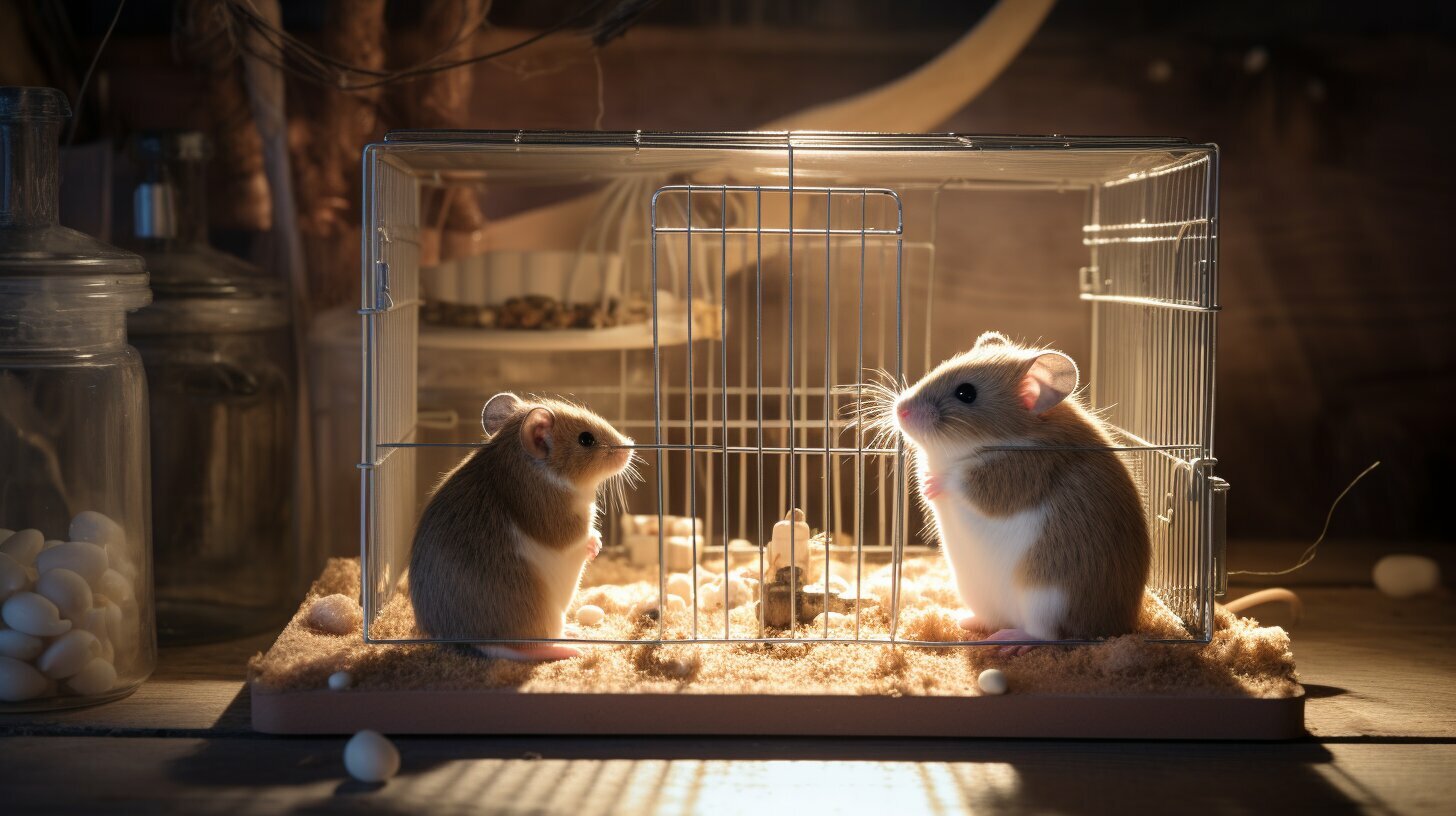Many people wonder if hamsters attract mice and if there are any concerns associated with their cohabitation. In reality, hamsters themselves do not attract mice. However, certain factors, such as uneaten food, improper living conditions, and the buildup of hamster waste, can invite mice into the home. This can pose risks to hamsters, including the potential transmission of diseases like Hantavirus and Salmonella.
It is crucial to keep hamsters and mice separate to prevent these dangers. While mice may attempt to enter a hamster’s cage to steal food, it is important to remember that hamsters are solitary animals and may become aggressive towards mice. For the well-being of both species, hamsters and mice should never be kept in the same cage.
Maintaining a clean and secure hamster environment is essential to minimizing the chances of mice infestations. Regularly cleaning the hamster cage and ensuring it is properly secured can help prevent mice from gaining access. Taking proactive measures to keep mice away from hamsters is crucial in providing a safe and healthy environment for your pet.
Key Takeaways:
- Hamsters themselves do not attract mice, but certain factors can invite mice into the home.
- Mice can pose risks to hamsters, including the potential transmission of diseases.
- Hamsters and mice should never be kept in the same cage due to aggression and compatibility issues.
- Maintaining a clean and secure hamster environment is vital for preventing mice infestations.
- Proactive measures should be taken to keep mice away from hamsters for their well-being.
Understanding Hamsters and Mice Interaction
It is important to understand the dynamics between hamsters and mice to ensure the safety and well-being of both animals. Contrary to popular belief, hamsters do not attract mice. However, certain factors may invite mice into the home, such as the presence of uneaten food, improper living conditions, and poop buildup. This can pose risks to hamsters as mice can bring danger and diseases like Hantavirus and Salmonella.
Hamsters are solitary animals and may become aggressive towards mice. Therefore, it is crucial to keep hamsters away from mice and never house them together in the same cage. Mice may try to enter a hamster’s cage to steal food, but it is important to prevent such behavior to ensure the hamster’s safety.
To minimize the chances of mice infestations, it is essential to maintain a clean and secure hamster environment. Regularly clean the hamster cage, removing any uneaten food or waste that could attract mice. Keep the cage well-ventilated and secure, preventing mice from gaining access. Taking these preventive measures will help keep mice away from hamsters and reduce the risks associated with their presence.
| Key Points: |
|---|
| – Hamsters do not attract mice |
| – Mice may be attracted to hamsters due to uneaten food, improper living conditions, and poop buildup |
| – Mice can pose risks to hamsters, including the transmission of diseases |
| – Hamsters are solitary animals and may become aggressive towards mice |
| – Keep hamsters and mice separate, never housing them in the same cage |
| – Maintain a clean and secure hamster environment to minimize the chances of mice infestations |
Factors that Can Attract Mice to Hamsters
Certain conditions and factors in a hamster’s environment can inadvertently attract mice, posing a risk to both the hamster and the overall household. It is important to be aware of these factors and take proactive measures to prevent mice infestations. The following are some key aspects that may attract mice to hamsters:
- Uneaten Food: Hamsters have a tendency to hoard food in their cages. If the hamster does not eat all the food provided, small bits may fall into crevices or corners, attracting hungry mice. Regularly clean the cage and remove any uneaten food to minimize the risk of mice being drawn to the area.
- Improper Living Conditions: A dirty and unkempt hamster cage can provide an ideal environment for mice to thrive. Mice are attracted to unclean areas, so it is crucial to maintain a clean and hygienic living environment for your hamster. Regularly clean the cage, dispose of soiled bedding, and sanitize the cage accessories to deter mice from entering.
- Poop Buildup: Hamsters produce waste in the form of droppings, and if not cleaned regularly, these droppings can accumulate and attract mice. Clean the cage daily and remove all droppings to prevent mice from being enticed by the scent and presence of waste.
By addressing these factors, you can significantly reduce the chances of attracting mice to your hamster’s living space. Implement a regular cleaning routine for the cage and ensure that all uneaten food is promptly removed. Maintaining a clean and secure hamster environment is essential for the health and safety of both your hamster and your household.
| Factors that Attract Mice to Hamsters | Prevention Measures |
|---|---|
| Uneaten Food | Remove uneaten food promptly and regularly clean the cage. |
| Improper Living Conditions | Maintain a clean and hygienic living environment for the hamster. |
| Poop Buildup | Regularly clean the cage and remove all droppings |
Remember, preventing mice from being attracted to hamsters is crucial for the well-being of your pet and the overall cleanliness of your home. By maintaining a clean and secure hamster environment, you can create a safe space for your furry friend and reduce the risk of mouse infestations in your household.
Risks of Mice Presence for Hamsters
Mice can pose significant dangers to hamsters, being potential predators and carriers of harmful diseases. As natural prey for mice, hamsters are at risk of being attacked and injured if they come into contact with these rodents. Additionally, mice can transmit diseases such as Hantavirus and Salmonella, which can be fatal to hamsters. Therefore, it is crucial to minimize the presence of mice near hamsters to ensure their safety and well-being.
Hamsters are solitary animals and have a natural tendency to become territorial. When confronted with the presence of mice, hamsters may exhibit aggressive behavior, which can lead to stress and potential harm to both animals. For this reason, it is essential to keep hamsters and mice separated at all times, preventing any direct interaction between them.
To minimize the risk of mice infestations, it is important to maintain a clean and secure environment for hamsters. Uneaten food left in the hamster’s cage can attract mice, so it is crucial to remove any leftover food promptly. Regularly cleaning the cage and removing any waste, such as soiled bedding or droppings, will also help deter mice from being attracted to the hamster’s living area.
| Risks of Mice Presence for Hamsters: | Prevention Measures: |
|---|---|
| Predation and physical harm | Keep hamsters and mice separated |
| Transmission of diseases | Minimize the presence of mice near hamsters |
| Aggressive behavior from hamsters | Maintain a clean and secure hamster environment |
Preventative measures include sealing any potential entry points for mice, such as gaps in walls or floors, and ensuring that the hamster’s cage is secure and inaccessible to rodents. Regularly inspecting the surroundings for signs of mice, such as droppings or chewed wires, can help detect any potential infestations early on.
By taking proactive steps to minimize the presence of mice near hamsters and maintaining a clean and secure environment, hamster owners can ensure the well-being and safety of their beloved pets.
The Aggressive Nature of Hamsters Towards Mice
Hamsters, being solitary animals, tend to exhibit aggressive behavior towards mice and should never be housed together. While hamsters may appear small and harmless, their instincts can kick in when faced with the presence of mice. In fact, hamsters view mice as potential threats and may display territorial aggression towards them.
It is crucial to understand that hamsters have their own personal space and need to feel secure in their environment. Introducing a mouse into a hamster’s cage can lead to fights and injuries, putting both animals at risk. The size difference between hamsters and mice further escalates the chances of harm, with hamsters potentially overpowering and injuring the smaller mice.
Hamsters rely on their strong sense of smell and perception of territory to mark their living spaces. The introduction of a mouse can disrupt this territorial balance, causing stress and anxiety for the hamster. Additionally, hamsters are known to be possessive of their food, and the presence of a mouse attempting to steal from their food bowl can trigger aggressive behaviors.
To ensure the well-being of both hamsters and mice, it is imperative to keep them separate. This means providing individual cages that meet their specific needs and ensuring there are no opportunities for them to come into direct contact. By keeping a clean and secure hamster environment, you can minimize the chances of mice infestations and protect your hamster from potential dangers.
| Hamster Behavior | Mice Behavior |
|---|---|
| Aggressive towards mice | May attempt to steal food |
| Reliant on strong sense of smell | Sensitive to surrounding odors |
| Territorial and possessive | Seeking food and shelter |
Maintaining a Clean and Secure Hamster Environment
To ensure the safety and well-being of your hamster, it is crucial to maintain a clean and secure environment that deters mice. While hamsters themselves do not attract mice, certain factors can invite these rodents into your home. By following some essential steps, you can minimize the chances of mice infestations and create a safe space for your beloved pet.
First and foremost, proper hamster cage cleanliness is vital. Regularly clean the cage, removing any uneaten food, feces, and bedding that may accumulate. Mice are attracted to the smell of food, so it is important to promptly remove any leftover food to prevent mice from being drawn to the cage.
In addition to cleanliness, it is essential to secure the hamster cage to prevent mice from gaining access. Check for any small gaps or openings that mice can squeeze through and seal them. This will make it difficult for mice to enter the cage and minimize the risk of them stealing the hamster’s food.
| Tips for Maintaining a Clean and Secure Hamster Environment |
|---|
| 1. Clean the hamster cage regularly, removing uneaten food and waste. |
| 2. Keep the cage securely closed to prevent mice from entering. |
| 3. Use a wire mesh or hardware cloth to cover any gaps or openings in the cage. |
| 4. Store hamster food in airtight containers to deter mice. |
| 5. Avoid placing the hamster cage near areas where mice are likely to be present, such as the kitchen or pantry. |
By following these guidelines, you can ensure that your hamster’s living environment remains clean and secure, minimizing the risk of mice infestations and creating a safe space for your furry friend.
Prevention Measures Against Mouse Infestations
By implementing certain preventative measures, you can significantly reduce the likelihood of mice infestations and the associated risks for your hamster. While hamsters do not attract mice themselves, it is important to be proactive in keeping these two rodents separate to avoid potential dangers and health hazards.
Keeping Hamsters and Mice Separate
Hamsters and mice should never be kept in the same cage or allowed to interact freely. Hamsters are solitary animals and may exhibit aggressive behavior towards mice, putting both species at risk. To prevent any unwanted encounters, ensure that your hamster’s enclosure is secure and mouse-proof. This will prevent mice from gaining access to the cage and stealing food, as well as minimize the risk of disease transmission.
Maintaining a Clean and Secure Hamster Environment
One of the key factors that can attract mice to hamsters is the presence of uneaten food and improper living conditions. To avoid inviting mice into your home, clean your hamster’s cage regularly, removing any uneaten food or food debris. Store hamster food in tightly sealed containers to prevent easy access for mice. Additionally, ensure that the cage is secure, with no gaps or openings that mice can squeeze through.
Additional Preventative Measures
In addition to keeping hamsters and mice separate and maintaining a clean environment, there are other preventative measures you can take to minimize the chances of mice infestations. Here are some recommendations:
- Seal any cracks or openings in windows, doors, and walls to prevent mice from entering your home.
- Keep your home clean and clutter-free, as mice are attracted to food and nesting materials.
- Store food in airtight containers and clean up any spills or crumbs promptly.
- Remove any outdoor food sources that may attract mice, such as bird feeders or unsecured garbage cans.
- If you suspect a mice infestation, contact a professional pest control service to address the issue promptly and effectively.
By following these prevention measures, you can create a safe and mouse-free environment for your hamster, reducing the risks associated with mice infestations. Remember, hamsters and mice are not compatible, and it is crucial to keep them separate to ensure the well-being of your furry friend.
Addressing Mouse Attempts to Steal Hamster Food
Mice may be enticed by the presence of hamster food and can pose a threat to hamsters if they attempt to steal their food. Although hamsters are solitary animals and prefer to eat alone, their food can attract mice due to its appealing aroma and taste. This can lead to undesirable interactions between hamsters and mice, potentially resulting in stress and aggression.
To prevent mice from stealing hamster food, it is crucial to take proactive measures. Firstly, ensure that the hamster’s cage is securely closed and free from any gaps or openings that mice could squeeze through. Regularly inspect the cage for any signs of damage or wear that could allow mice to gain access.
Avoid leaving excess food in the hamster’s cage for extended periods. Instead, provide fresh food in appropriate-sized portions that the hamster can consume within a short period. If the hamster has a habit of hiding food, consider removing any uneaten food before the lights are turned off, as this is when mice are most active.
| Preventative Measures Against Mouse Attempts to Steal Hamster Food |
|---|
| Regularly inspect the hamster’s cage for any openings or damage that mice could use to gain access. |
| Provide fresh food in portioned quantities that the hamster can consume within a short period. |
| Remove any uneaten food from the cage before turning off the lights, as mice are most active during the night. |
| Consider using a weight-controlled food dish that only provides access to the hamster’s food when its weight is detected. |
If the problem persists despite taking these preventative measures, consider using a weight-controlled food dish. These dishes only provide access to the hamster’s food when its weight is detected, effectively preventing mice from stealing the food.
Remember, it is crucial to keep hamsters and mice separate. Hamsters are solitary animals and may become aggressive towards mice if they feel threatened. Additionally, mice can carry diseases such as Hantavirus and Salmonella, which can pose serious health risks to hamsters. By addressing mouse attempts to steal hamster food and creating a clean and secure environment, you can minimize the risks associated with hamsters and mice interaction.
Hamster and Mouse Cohabitation Concerns
Cohabiting hamsters and mice can lead to various risks and negative outcomes for both animals, making it imperative to keep them separated. While hamsters and mice may both be small rodents, they have different social structures and behaviors that can clash when housed together. Attempting to keep them in the same cage can result in stress, aggression, and even harm to one or both animals.
Hamsters are solitary creatures, preferring to live alone in their own territory. They are territorial and may become aggressive towards other animals, including mice, if their personal space is invaded. This can lead to fights, injuries, and even death for either animal. It is essential to provide a separate and secure living environment for hamsters to ensure their well-being.
Mice, on the other hand, are highly social animals that thrive in groups. When housed with hamsters, they may become stressed and anxious due to the lack of social interaction. Mice can also be carriers of diseases such as Hantavirus and Salmonella, which can be transmitted to hamsters, posing a serious health risk.
To prevent the risks associated with cohabitation, it is crucial to keep hamsters and mice in separate cages. Hamster cages should be kept clean and free from any food debris or waste that may attract mice. Regular cleaning and proper maintenance of the hamster’s environment will help minimize the chances of a mouse infestation.
| Risks of Cohabitation: | Preventive Measures: |
|---|---|
|
|
In conclusion, cohabiting hamsters and mice can result in undesirable outcomes for both animals. It is essential to prioritize their individual needs and keep them separated to ensure their well-being and safety. By providing separate living spaces and maintaining cleanliness, you can minimize the risks associated with rodent attraction and maximize the health and happiness of your hamster.
Conclusion
In conclusion, while hamsters do not inherently attract mice, certain factors can invite mice into their environment, posing risks that should be mitigated by maintaining a clean, secure, and mice-free space for your hamster.
Mice are attracted to the presence of hamsters’ uneaten food, improper living conditions, and the buildup of their waste. When mice infest a hamster’s habitat, they can introduce dangers such as Hantavirus and Salmonella which can harm or even be fatal to your beloved pet.
It is crucial to keep hamsters away from mice to prevent these risks. Hamsters are naturally solitary animals and may become aggressive towards mice if they share the same space. It is essential to never keep hamsters and mice in the same cage to avoid potential harm to both animals.
To maintain a clean and secure hamster’s environment, it is important to regularly clean their cage, dispose of uneaten food promptly, and keep the area around the cage free of any leftover food. By doing so, you can minimize the chances of attracting mice and decrease the risk of infestations.
Remember, prevention is key. Taking proactive measures such as sealing any possible entry points, storing food properly, and using appropriate pest control methods can help keep mice away from your hamster’s living space.
FAQ
Q: Do hamsters attract mice?
A: No, hamsters do not attract mice. However, the presence of hamsters’ uneaten food, improper living conditions, and poop buildup may invite mice into the home.
Q: What risks do mice presence pose for hamsters?
A: Mice can bring danger and diseases to hamsters, such as Hantavirus and Salmonella. It is important to keep hamsters away from mice to prevent these risks.
Q: Can hamsters and mice be kept in the same cage?
A: No, hamsters and mice should never be kept in the same cage. Hamsters are solitary animals and may become aggressive towards mice.
Q: How can I prevent mice infestations near hamsters?
A: It is important to keep the hamster cage clean and secure to prevent mice infestations. Regularly clean the cage and ensure it is properly sealed.
Q: Why should hamsters and mice be kept separate?
A: Hamsters and mice have different needs and behaviors. Keeping them separate helps to avoid issues and potential harm to both animals.




